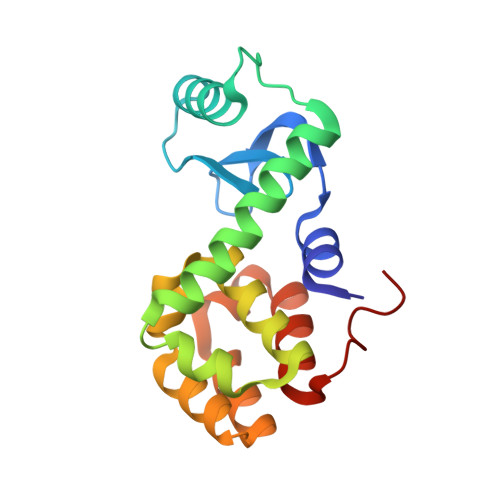Structural basis of the conversion of T4 lysozyme into a transglycosidase by reengineering the active site.
Kuroki, R., Weaver, L.H., Matthews, B.W.(1999) Proc Natl Acad Sci U S A 96: 8949-8954
- PubMed: 10430876
- DOI: https://doi.org/10.1073/pnas.96.16.8949
- Primary Citation of Related Structures:
1QT3, 1QT4, 1QT5, 1QT6, 1QT7, 1QT8, 1QTV, 1QTZ - PubMed Abstract:
In contrast to hen egg-white lysozyme, which retains the beta-configuration of the substrate in the product, T4 lysozyme (T4L) is an inverting glycosidase. The substitution Thr-26 --> His, however, converts T4L from an inverting to a retaining enzyme. It is shown here that the Thr-26 --> His mutant is also a transglycosidase. Indeed, the transglycosylation reaction can be more effective than hydrolysis. In contrast, wild-type T4L has no detectable transglycosidase activity. The results support the prior hypothesis that catalysis by the Thr-26 --> His mutant proceeds via a covalent intermediate. Further mutations (Glu-11 --> His, Asp-20 --> Cys) of the T26H mutant lysozyme indicate that the catalytic mechanism of this mutant requires Glu-11 as a general acid but Asp-20 is not essential. The results help provide an overall rationalization for the activity of glycosidases, in which a highly conserved acid group (Glu-11 in T4L, Glu-35 in hen egg-white lysozyme) on the beta-side of the substrate acts as a proton donor, whereas alterations in the placement and chemical identity of residues on the alpha-side of the substrate can lead to catalysis with or without retention of the configuration, to transglycosidase activity, or to the formation of a stable enzyme-substrate adduct.
Organizational Affiliation:
Central Laboratories for Key Technology, Kirin Brewery Co., Ltd., 1-13-5, Fukuura, Kanazawa-ku, Yokohama 236 Japan.
















